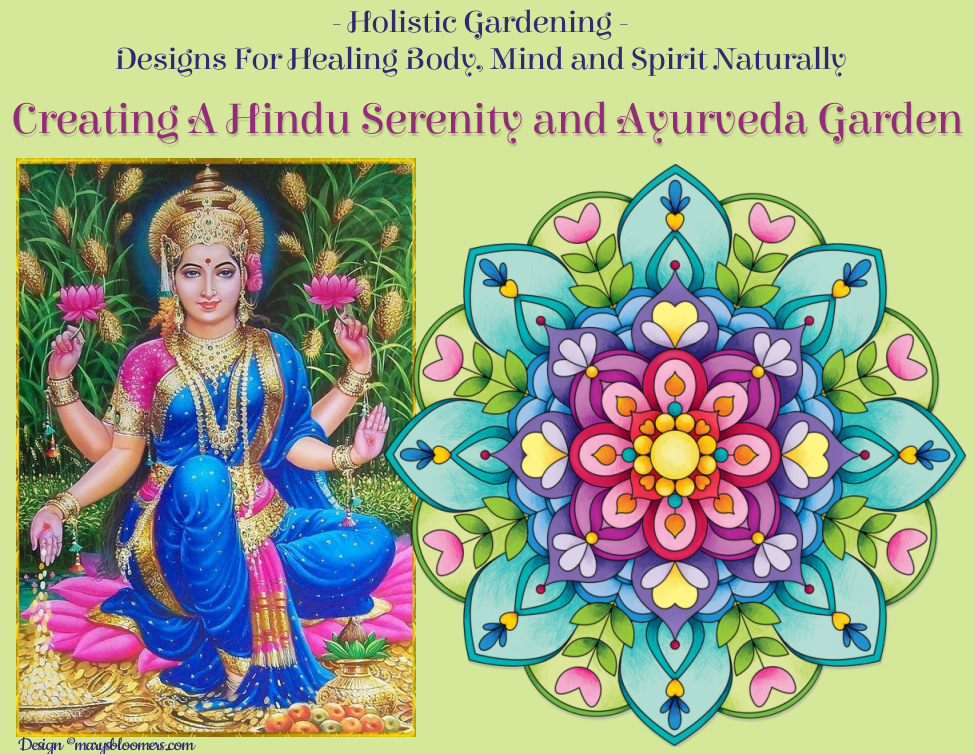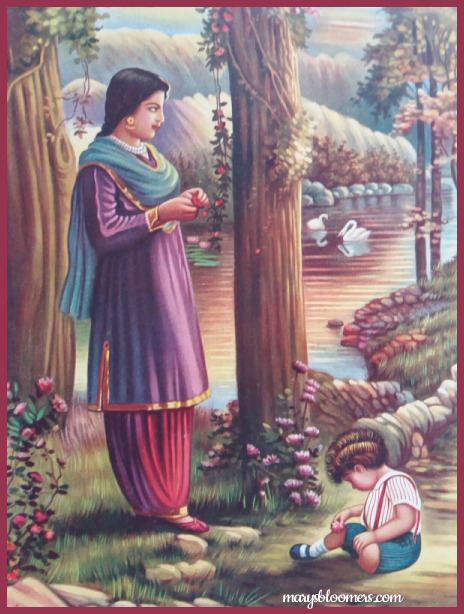 |
|
Most historians believe Hinduism is the world’s oldest religion, and it is widely practiced in countries around the world. Hindu temple gardens are places of worship, designed to connect people with gods, and the gardens are filled with symbolism that reflects Hindu values. The garden should be informal and cater to your personal serenity goals, spirituality, healing and meditation needs. In Hinduism, plants and trees have always been significant and revered. In sacred Hindu texts, there are many references signifying growing trees, creating gardens and woodlands. The customary plantings encourage positivity, and are also widely used for medicinal and ornamental purposes. Plants to include in an Ayurvedic Healing Garden are listed here--> This garden
can be valuable not only for meditation and reflection, but it can also
accommodate a space for your yoga practice. My attraction to Hindu gardens is based upon my love of bright color pops in a garden and in my favorite Indian artwork. You wouldn't think of lots of color as conducive to meditation and serenity. But serenity is as serenity does... My spirit is brighter in those colorful and artistic spaces. I am also a big fan of Zen and Asian Gardening. I react to the symbolism of the flowers and garden sculptures, as well. Ideas for creating your Hindu garden Hindu gardens are not necessarily a religious design statement. Sacred gardens can be designed to reflect your religious beliefs, but many times, the gardens we create reflect our reverence for the ideals or ideas common to the religion, along with our reverence for Mother Nature. Design, thy name is "authenticity". My garden decor contains works of art and sculpture that represent holy beings like angels, Blessed Virgin, St. Francis, Buddha, and other sacred representations. We can be a different religion or no religion at all in relation to our garden's styles. Many Zen gardens reflect the religious aspect of Buddhism and Hinduism, but they are designed around the concepts of serenity, peace, goodwill and ethnic art appreciation. Biblical Gardens are not necessarily a religious statement - it's about historical use of sacred, culinary and symbolic plants available and grown in Biblical times. Our spaces reflect our inner selves and interests. Culinary and herbal areas in a garden reflect our food choices and healing practices, and the garden in its entirety usually reflects a design style particular to certain regions and the beliefs or styles that dominate. If I had enough land, I'd grow a United Nations Garden containing "rooms" reflecting the natural beauty of all regions. I love the art of all nations and ethnicities, and they all have a place in my serenity and love of Nature. I am also a shameless foodie and hobby herbalist, so my garden designs usually contain plantings of herbs, spices, and other culinary ingredients. On to the design ideas..... Include A Bird and Pollinator Habitat Hindu gardens often include refuge for birds and other wildlife. Hindu garden designs are based upon the principal that everything in the universe is sacred. You can easily incorporate water features in these habitats - like fountains and birdbaths, bird feeders, chimes and butterfly bushes to create a fragrant buffet for butterflies and birds, and to provide amazing fragrances while you meditate or sit in the garden in the evening. Many garden plants and vines attract hummingbirds, as well. Most flowers and vines with tubular-shaped flowers will attract hummers and butterflies. Trumpet vines, honeysuckle and agastache are the plants that are hummingbird magnets in my gardens. Birds will like the shelter and food, and will probably raise their young in a safe and quiet environment. Daily birdsong and a garden just about bug-free will be the gifts you will receive in return. There are solar fountain disks that will float in birdbaths with little spray nozzle attachments available at a reasonable price. Birds love the moving water and sprays. A pot of Milkweed somewhere is not only very pretty, but it will attract and feed the endangered Monarch Butterfly and larvae. This garden area doesn't need to be large - you can fit this garden into just about any nook. Symbolism, garden sculptures and ornament
The
Buddha
A mandala is a representation of the cosmos, with the god and his palace at the center. Hindu temples are 3-dimensional mandalas. They are rectangular enclosures with a sanctuary at the center, a tall structure to represent Mount Meru (the center of the universe). A traditional mandala is a geometric configuration of symbols. In various spiritual traditions, mandalas may be employed for focusing attention of practitioners and as a spiritual guidance tool, for establishing a sacred space and as an aid to meditation and trance induction. In the Eastern religions of Hinduism, Buddhism, Jainism and Shintoism it is used as a map representing deities, paradises, or actual shrines. The mandala generally represents the spiritual journey, starting from outside to the inner core, through layers. In spiritual or religious process, a mandala is a period of approximately 40 days in which time the human system completes one physiological cycle. In Hinduism, a basic mandala, also called a yantra, takes the form of a square with four gates containing a circle with a center point. Each gate is in the general shape of a T. Mandalas often have radial balance. "A yantra is similar to a mandala, usually smaller and using a more limited color palette. It may be a two- or three-dimensional geometric composition used in meditative rituals, and may incorporate a mantra into its design. It is considered to represent the abode of the deity. Each yantra is unique and calls the deity into the presence of the practitioner through the elaborate symbolic geometric designs. According to one scholar, "Yantras function as revelatory symbols of cosmic truths and as instructional charts of the spiritual aspect of human experience" - Wikipedia Om
Symbol
"OM"
is symbolic of the Universe and the ultimate reality. Meditation Stones, Backless
Garden Benches Rain Chains, Asian-theme hanging Bells and Musical Wind chimes Solar Lanterns, Lamps and
small Warm White String Lights Use warm white solar lighting. Avoid using color or blue white lights. The bright blue white lights are too glaring and don't emit a soft glow. You want an understated and lovely glow to fit in with the serenity and harmony atmosphere you wish to create. Use a steady glow setting - blinking lights are for Christmas trees, and can annoy, rather than soothe. There's a reason why romantic cafe and restaurant patio gardens have little trees with and plants with white lights that don't blink. Small mason jars filled with little solar light strings can have the slow and subtle twinkle setting if they are hung far apart along a garden walkway or amid mass plantings and aren't too obvious. Water
Features Incorporate a small and
ornamental Ayurvedic herbal garden Sacred and Temple Plants In Hindu Gardens Hinduism is a nature-loving faith. There are references to gardens in Hindu literature, including lotus-shaped baths and lakes, and creeper pavilions. Stories about Krishna appear to be set in a garden context. Many groves or forests were sacred in ancient India, and they continue to be sacred in modern Hindu worship. Mandalas Hindu Monastery Garden, Kauai, Hawaii
It is traditional for Hindu temples to cultivate beautiful garden grounds, filled with flowers to be offered in holy ceremony, as well as fruits and even medicinal resources. The surrounding groves, gardens and ponds display hundreds of blossoming trees, exotic tropical flowers, and bamboos soaring to 100 feet. Pilgrims may sit and meditate by the 180-foot-wide natural-rock river pond. These gardens in Hawaii are filled with plumeria, konrai groves, hibiscus fields, fruit orchids, palm groves, tree ferns, breadfruit, taro, fragrant vines, native species, mosses and ferns, waterfalls, massive banyans and redwood pavilions. Sacred and ayurvedic plants from India and Sri Lanka—bilva, neem, amla, curry leaf, rudraksha, betel, champaka and areca nut—have been brought to the island. The Kauai monastery features beautiful ponds, waterfalls and secluded marshes, providing refuge for birds, and a habitat for water lilies and sacred lotuses. Tropical flowers include 300 varieties of heliconia and ginger, 250 kinds of ti plants, hundreds of exotic palms, bromeliads and an arid garden with cacti, agaves and desert succulents.
If certain plants listed below aren't hardy in your region, feel free to substitute a similar-looking hardy plant, or grow these in containers that can be brought indoors in winter. Bamboo (clumping, not running) is awesome all around the garden for a Zen and Hindu look - and there are so many clumping and well-behaved varieties, they can be planted in-ground and in containers, indoors and outdoors. I have lots of them..... along with my potted jade trees, in all of my Zen and Asian garden designs. Potted plants are mobile, easy to care for, allow twice as much or more space in the garden, and the pots can be awesome, too. Pots - You can choose from beautiful Asian style pots and contemporary pots with clean lines and primary colors. They all look great. Use big plastic pots with drainage holes. Much lighter to move around with the plant in it. I am addicted to clay and stone pots - so I sometimes have to drill a small hole in those that don't have them, if they will winter outdoors. ***Some of these ornamental and medicinal plants are toxic to pets and children if ingested - do not grow these unless you can keep them away from each other. There are many types of Hindu Garden plants and there are probably several substitutes available for them, in terms of design, intent, and symbolism. If you are unsure, look up the plant variety and it's characteristics. Many plants in traditional Indian/Hindu gardens will have names you are not at all familiar with, and you might have difficulty finding them. There are substitutes you can use for the symbolism, and there might be nurseries online that sell exotic or rare plants. This is where container gardening comes in handy. You can move these hot weather plants indoors and use them as houseplants in winter, and those that go dormant can live in a shed or unheated basement until breaking dormancy and being placed back into the garden in warm spring weather. I found the listings interesting, because most of the plants evoke a strong and exotic fragrance that can feel hypnotic. Jasmine Vine I grow Jasmine outdoors in pots, and bring them in for our cold winter, where they continue to offer blooms and incredible fragrance. Great in hanging baskets indoors and out, or planted around a trellis, arbors or stakes. It is either deciduous or evergreen, blooming in summer and springs, depending upon variety and your hardiness zone. It releases a beautiful and exotic fragrance, especially in the night. It's easy to care for, if you keep up with pruning the vines and keeping them bushy, neat and tidy, confine their space, and keep them tied to or climbing something specific. Tuberose
Periwinkle Vines Datura (Datura stramonium) Ficus Religiosa - Bodhi Tree Ashoka Tree Banyan tree Sandalwood
Tree Holy Basil - Tulsi Aegle Marmelos (Baelpatra) Hardy Giant Hibiscus/Tropical
Hibiscus (you can
grow Tropical Hibiscus if you live in hot regions, or grow them in containers
and pots and bring indoors in winter in cold regions). Hardy Giant
Hibiscus has a limited color palette. Tropical Hibiscus has many colors
and hues in the warm palette. Marigolds
Plumeria (Frangipani) Magnolia Oleander Mango Neem Banana Tree Prosopis Cineraria (Shami) Jimson Weed (Dhatura)
Although Dhatura is poisonous, the application of its juice on hair and scalp is said to prevent hair loss and dandruff. It flowers at night in shades of purple, cream, and white. The plant thrives in a warm climate and moist soil, and in full sun. Lotus The Rose Irises Additional
ornamental plants grown in India that will feel right at home in a Hindu
Serenity Garden design. Most do very
Ayurvedic Plants For A Hindu Herbal Garden Know and grow these
science and research-backed medicinal plants that are an integral part Ayurveda is an ancient form of medicinal practice originating in India. The plants listed below are easy to grow, and practitioners or devotees of Ayurvedic medicine may consider these plants useful tools in the holistic healing toolboxes. Many of these plants are well-known to gardeners as ornamentals or used in culinary recipes. These plants are suggested as part of a traditional ornamental medicinal plant garden within your Hindu Garden design. For any plant
recommendations or mention of ingesting medicinal herbals, I am
required to make this disclaimer: Best advice I can offer: Don't use plants as medicine if you don't know what you're doing. Consult with a qualified holistic or ayurvedic practitioner. - "Despite the fact that ayurvedic medicines are based on natural herbal materials, their safety depends on their method of administration, taking account of individuals’ needs and their specific disease conditions. The unguided consumption of ayurvedic preparations, in the mistaken belief that spices and herbs will necessarily be safe, may lead to serious health issues. A thorough awareness of these plants’ actions is needed for their safe selection and consumption." - US National Institute of Health Ayurvedic practice is approximately 3000 years old, with a long history of managing disease. The 3 basic principles, called doshas (vata, pitta, and kapha), are derived from 5 elements of Indian philosophy. Approximately 90% of ayurvedic preparations are plant based. Ayurvedic plants have a stronger action on the body than either food or spices, and should be used with caution. Treatment starts with an internal purification process, followed by a special diet, herbal remedies, massage therapy, yoga, and meditation. Traditional ayurvedic texts note that quality-assured ayurvedic compounds are strong and potent enough to combat disease. The parts of the plants chosen for use are also important. Depending on the plants used, and the medical combinations involved, the leaves, flowers, seeds, bark, roots, or skin of the plant may be chosen. The particular combination chosen by the practitioner results from extensive practical experience of the constituents needed to achieve the maximal healing effect. In ayurveda, most of the classical preparations are polyherbal, with a combination of 3 to 30 plants involved. These constituents are combined accurately, in such a way that the formula is balanced and reproducible. One or two of the plants in these combinations will be active and the others will play a supporting role. The supporting herbs will each have different actions, acting as catalysts to help proper absorption, transportation, and to reduce toxicity. If an ideal combination is delivered, then the result can be excellent, but such outcomes are based on thorough plant knowledge. Popular Ayurvedic Herbs and Medicines Several of these herbs are also culinary spice and seasoning favorites. Those, I gladly recommend as an addition to your ornamental and edible gardens. I use many of them myself in Asian style cooking. Ornamentals like Hibiscus, Feverfew, chamomile, lavender, etc., have earned a spot in any ornamental and culinary herbal garden design. *= I've successfully grown these plants in my zones 5, 6b and 8 gardens, and indoors as houseplants. As always, check the USDA Cold Hardiness Zone Map for plants that will grow in your region, or treat as annuals and bring/grow them indoors. Many of these plants have desirable ornamental value, as well. Be sure to check toxicity and aggressive growth (invasiveness) characteristics before planting and ingesting them. Do not diagnose or treat yourself. These are suggestions for a garden theme's visual beauty and accuracy. They are not medicinal use recommendations.
I always wondered about the symbolism and I now have the answer.... Hindu gods are generally depicted with multiple arms in order to visually represent their supreme powers and superiority over humankind.
Article
©2020 Mary Hyland Resources:
|
Content, graphics,
photos and design ©2020 marysbloomers.com™
All rights reserved.





